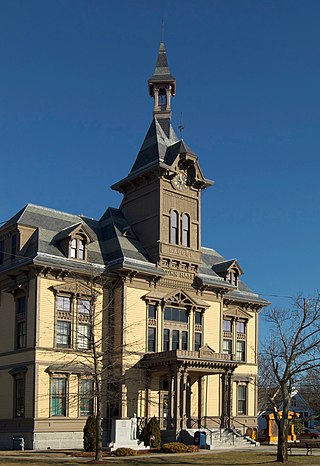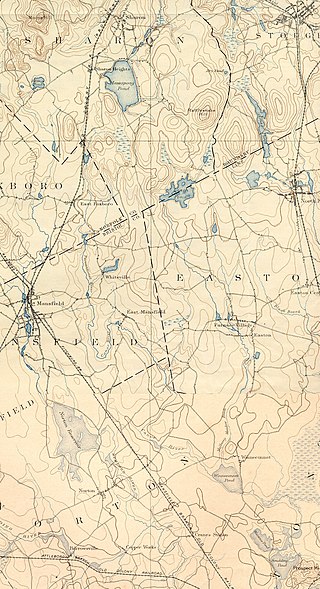
Newton is a city in Middlesex County, Massachusetts, United States. It is approximately 7 miles (11 km) west of downtown Boston, and comprises a patchwork of thirteen villages without a city center. It is home to the Charles River, Crystal Lake, and Heartbreak Hill, among other landmarks. It is served by several streets and highways, as well as the Green Line D branch run by the MBTA.

Salisbury is a town situated in Litchfield County, Connecticut, United States. The town is the northwesternmost in the state of Connecticut; the Massachusetts-New York-Connecticut tri-state marker is located at the northwest corner of the town. The population was 4,194 at the 2020 census. The town is part of the Northwest Hills Planning Region.

Saugus is a town in Essex County, Massachusetts, United States, in the Greater Boston area. The population was 28,619 at the 2020 census. Saugus is known as the site of the first integrated iron works in North America.
The year 1814 in science and technology involved some significant events, listed below.
Elisha King Root was a Connecticut machinist, inventor, and President of Colt's Manufacturing Company.

Simeon North was an American gun manufacturer, who developed one of America's first milling machines in 1818 and played an important role in the development of interchangeable parts manufacturing.

The Blackstone Valley or Blackstone River Valley is a region of Massachusetts and Rhode Island. It was a major factor in the American Industrial Revolution. It makes up part of the Blackstone River Valley National Heritage Corridor and National Historical Park.

Eli Terry Sr. was an inventor and clockmaker in Connecticut. He received a United States patent for a shelf clock mechanism. He introduced mass production to the art of clockmaking, which made clocks affordable for the average American citizen. Terry occupies an important place in the beginnings of the development of interchangeable parts manufacturing. Terry is considered the first person in American history to actually accomplish interchangeable parts with no government funding. Terry became one of the most accomplished mechanics in New England during the early part of the nineteenth century. The village of Terryville, Connecticut is named for his son, Eli Terry Jr.

The Blackstone Canal was a waterway linking Worcester, Massachusetts, to Providence, Rhode Island through the Blackstone Valley via a series of locks and canals during the early 19th century. Construction was started in 1825, and the canal opened three years later. Following the opening of the Boston and Providence Railroad in 1835, the canal struggled for business. It was ultimately replaced by the Providence and Worcester Railroad, which completed a parallel line in 1847. The canal shut down in 1848. Several segments of the canal are preserved, with the canal alignment and remains listed on the National Register of Historic Places.
Arlington High School is a public high school located in Arlington, Massachusetts. As of 2022, the school enrolled 1,483 students.

The Canoe River is a river in southeastern Massachusetts. It is 14.4 miles (23.2 km) long and part of the Taunton River Watershed.

Clay Pit Pond, also known as Claypit Pond, is a pond in the Boston suburb of Belmont in Middlesex County, Massachusetts situated between Concord Avenue and Belmont High School. It is a man-made pond, excavated as the source of clay for industrial brick-making on the site from 1888 to 1926. The pond was formed in 1933 when the Wellington Brook was redirected to flood the site, making it an essential part of the drainage system for much of Belmont.
Diana Muir, also known as Diana Muir Appelbaum, is an American historian from Newton, Massachusetts, best known for her 2000 book, Reflections in Bullough's Pond, a history of the impact of human activity on the New England ecosystem.

Reflections in Bullough's Pond: Economy and Ecosystem in New England is a book by Diana Muir, published in 2000. Providence Journal called Bullough’s Pond "a masterpiece", and Publishers Weekly called it "lyrical". The Massachusetts Center for the Book awarded it the 2001 Massachusetts Book Award, for the author's "engaging and accomplished storytelling".

Crystal Lake is a 33-acre (130,000 m2) natural great pond located in Newton, Massachusetts. Its shores, mostly lined with private homes, also host two small parks and a designated swimming area with a bathhouse. The public is not allowed to swim outside of the small swimming area.

Lake Massapoag is a 353-acre (1.43 km2), natural, springfed lake located in Sharon, Massachusetts. The name Massapoag is Algonquin, meaning "large water".

Ascutney Mill Dam, also known as the Windsor Upper Dam and the Mill Pond Dam, is an arch-gravity dam which is one of the oldest and among the earliest storage dams in the United States. It is made of cut granite and is located in Windsor, Vermont in Windsor County near the Connecticut River, where it functioned as a source of hydropower and, later, hydroelectric power. It is on the ASCE list of historic civil engineering landmarks since 1970 and is listed on the National Register of Historic Places since January 09, 2007.

Rocky Woods is a 491-acre (199 ha) open space preserve located in Medfield, Massachusetts. The preserve, managed by the land conservation non-profit organization The Trustees of Reservations, is notable for its rugged terrain. Rocky Woods offers 6.5 miles (10.5 km) of trails and former woods roads available for hiking, horseback riding, mountain biking, dog walking, catch and release fishing, camping, snowshoeing and cross country skiing. The preserve is part of a larger area of protected open space including the abutting Fork Factory Brook preserve, also managed by The Trustees of Reservations.

Stony Brook is a stream largely running through Lincoln and Weston, Massachusetts, then forming the Weston/Waltham boundary, and emptying into the Charles River across from the Waltham/Newton boundary. It has two tributaries, Cherry Brook and Hobbs Brook, and its watershed includes about half of Lincoln and Weston as well as parts of Lexington and Waltham. Since 1887, it has been the water supply for Cambridge, along with the Hobbs Brook Reservoir.

Humaston Brook State Park is an under-developed day use state park located in the village of Northfield, Connecticut. It preserves a stretch of Humaston Brook, a tributary of the Naugatuck River. Its major feature is Northfield Pond, created by damming in the 19th century. It is commonly known by residents as Knife Shop Pond. It also includes the foundations of the former Northfield Knife Company located along the banks of the brook below the dam, which was the location of one of Litchfield's largest 19th-century employers. Activities in the park include hiking and fishing.























